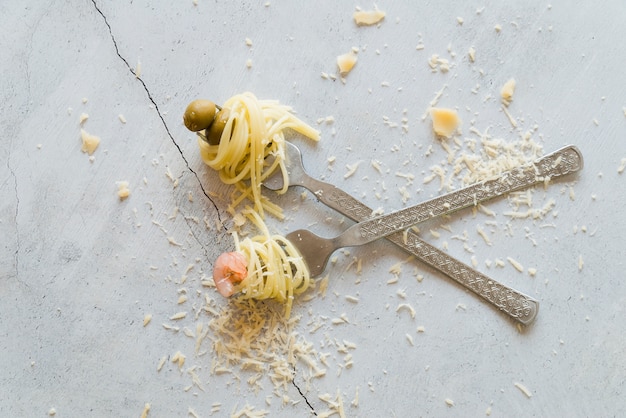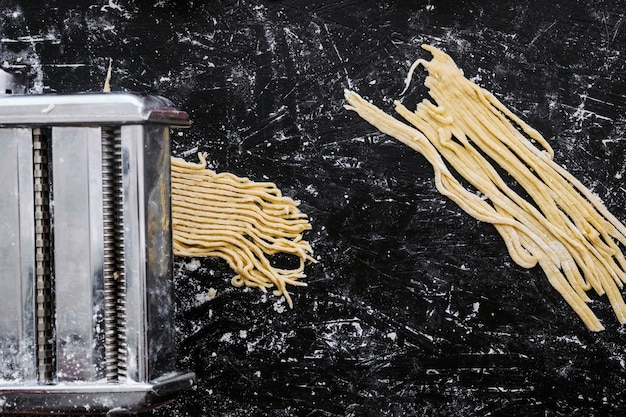Let's talk spaghetti. I mean, who doesn't love a good plate of spaghetti? It's a classic comfort food, a blank canvas for all sorts of delicious sauces, and honestly, it's just plain delicious. But let's be real, getting those perfect spaghetti noodles isn't always easy. You've got the soggy, mushy noodles, the hard and crunchy ones, and then there's the dreaded clumping. It's enough to make you want to order a takeaway, right?
Well, fear no more, my fellow pasta enthusiasts! I'm here to share my tried-and-tested secrets to cooking perfect spaghetti noodles every single time. You won't have to worry about soggy or crunchy pasta ever again. Get ready to become a pasta-cooking pro!
(Part 1) The Importance of Water: Your Pasta's Secret Sauce

Let's start with the basics: the water. It's not just about boiling it, it's about getting the water absolutely right. You see, the water is the key to achieving perfectly cooked pasta. Think of it as your pasta's secret sauce.
A Sea of Water: Don't Skimp on the Quantity
Firstly, the golden rule is to use plenty of water. You want your pasta to swim, not struggle in a crowded pot. A good rule of thumb is to use about 6-8 litres of water for a pound of pasta. This ensures that the water doesn't cool down too much when you add the pasta, keeping the cooking temperature consistent. You don't want to see your water turning into a pasta soup!
Salt, Salt, Salt! It's Not Just for Taste
Now, let's talk about salt. It's not just for flavour. Adding salt to your water is crucial for two reasons. Firstly, it helps season the pasta itself. Secondly, salt raises the boiling point of the water, making it cook more evenly. So, don't be shy with the salt. Add about a tablespoon or two to that big pot of water before it comes to a boil. Trust me, your taste buds (and your pasta) will thank you.
The Boil: A Furious Frenzy
Bring the water to a rolling boil before adding the pasta. It's not just a matter of temperature, it's about that vigorous bubbling action. You want those little bubbles to work their magic on your pasta, ensuring even cooking and a perfect texture.
(Part 2) The Pasta: A Guide to Picking the Right Noodle

Okay, we've got the water sorted, now let's talk about the star of the show: the pasta! There are so many different shapes and varieties of pasta out there, it can be overwhelming. But don't worry, I'll guide you through it.
Spaghetti: The Classic Choice
For this guide, we're focusing on spaghetti. Why? Because it's a classic. It's versatile, it's delicious, and it's a crowd-pleaser. But even within spaghetti, there are options! You've got your basic spaghetti, then you've got thicker strands like "spaghetti alla chitarra" which are amazing with a chunky tomato sauce. There's also "spaghettini" which is thinner than your classic spaghetti and perfect for lighter sauces.
Choosing the Right Pasta: Read the Packaging!
It's essential to choose the right type of pasta for your dish. You can find this information on the packaging. Look for "durum wheat semolina" on the ingredients list. This is a type of hard wheat that gives pasta its firmness and prevents it from becoming mushy.
fresh pasta: A Whole New Level
Now, if you're feeling really adventurous, consider making your own fresh pasta. It's a bit of a project, but trust me, it's worth it! Fresh pasta has a different texture and flavour, and it just tastes amazing. You can find recipes online or in cookbooks.
(Part 3) The Art of Adding Pasta: Gentle and Gracious

Here's where it gets real. Adding the pasta to the boiling water is like a delicate dance. You want to make sure the water doesn't stop boiling, but also that you don't shock the pasta.
The Gentle Stir: Prevent Sticking and Clumping
Add your pasta slowly to the boiling water, stirring gently to prevent it from sticking together. Don't dump it all in at once, it will lower the temperature too quickly and your pasta will end up unevenly cooked. Remember, it's a gentle ballet, not a pasta wrestling match!
Don't Overcrowd the Pot: Give It Space to Breathe
Don't overcrowd the pot. Leave some space for the pasta to move around freely. If you add too much pasta, it will absorb all the water, making it stickier.
(Part 4) The Cooking Process: Time is of the Essence
Now we're in the heart of the matter. The cooking time is absolutely critical. This is where you really need to pay attention, and it's a bit of a trial-and-error process.
Check the Instructions: A General Guide
The package instructions will give you a general guideline for cooking time. But remember, everyone's stove and pots are different, so it's important to check the pasta for doneness.
The Al Dente Test: Firm But Not Hard
You want your pasta to be "al dente," which means "to the tooth." It should be cooked through but still have a slight firmness to the bite. To test for doneness, take a strand of pasta and bite into it. It should be cooked but not mushy.
Don't Overcook: The Soggy Pasta Disaster
Overcooking is a common mistake. If you cook your pasta for too long, it will become mushy and lose its texture.
(Part 5) Draining the Pasta: A Quick and Efficient Method
Okay, the pasta is cooked, now it's time to drain it. It seems simple, but there are some tricks to ensure you don't end up with a soggy mess.
The Strainer: Your Pasta's Savior
Use a colander or strainer to drain the pasta. Make sure it's large enough to hold all the pasta without overcrowding.
The Drain-and-Reserve Technique: Saving the pasta water
Now, here's a little trick I love: the drain-and-reserve technique. As you're draining the pasta, reserve a cup or two of the starchy pasta water. This water is a magical ingredient that can be used to thicken sauces and create a smoother, creamier finish.
(Part 6) The Finishing Touch: A Symphony of Flavor
We're almost there! Now we're going to put the finishing touches on our perfect spaghetti.
The Sauce: Your Culinary Canvas
Now, this is where your creativity really shines! You can use any sauce you like, but I recommend choosing one that complements the flavour of the pasta. Here are a few ideas:
- Tomato Sauce: A classic and always a crowd-pleaser.
- Creamy Sauce: Creamy sauces like Alfredo or carbonara are delicious with spaghetti.
- Pesto: A refreshing and aromatic sauce made with basil, pine nuts, and Parmesan cheese.
- Seafood Sauce: A delightful blend of seafood, garlic, and white wine.
- Puttanesca: A flavorful sauce with olives, capers, and anchovies.
- Aglio e Olio: A simple yet delicious sauce made with garlic, olive oil, and red pepper flakes.
- Bolognese: A rich and meaty sauce that is perfect for a hearty meal.
The Toss: A Gentle Blend of Flavors
Add your chosen sauce to the drained pasta and toss gently to coat it evenly. Don't forget to use that reserved pasta water to create a silky smooth sauce. Remember, this is a delicate dance, not a pasta wrestling match!
The Garnish: A Touch of Elegance
A sprinkle of fresh Parmesan cheese, a drizzle of olive oil, a few sprigs of basil – these are the finishing touches that elevate your spaghetti from good to great.
(Part 7) The Plate: A Visual Feast
It's time to plate your culinary masterpiece. It's not just about the taste; it's about the presentation. It's time to give your spaghetti the stage it deserves.
The Serving: A Generous Portion
Serve your spaghetti on a large plate or bowl. It’s a celebration of deliciousness, so don’t be shy with the portion size! A generous serving is always better!
The Garnish: A Touch of Creativity
Now, don't be afraid to get creative with your presentation. You can add a sprinkle of fresh herbs, a dollop of cream, a few roasted vegetables – anything that will enhance the visual appeal of your dish.
(Part 8) The Final Bite: A Moment of Pure Joy
It’s time for the moment of truth: the first bite. This is where all your hard work comes together, and your taste buds are rewarded. The perfect spaghetti is a symphony of flavors and textures.
The Experience: A culinary journey
Savour each bite, letting the flavours dance on your tongue. Enjoy the al dente texture of the pasta, the richness of the sauce, and the subtle sweetness of the garnish.
The Satisfaction: A Pasta Perfectionist
And there you have it, my friends! You've just created a plate of perfect spaghetti, a testament to your dedication and culinary skills. You can now proudly call yourself a pasta perfectionist.
(Part 9) The Importance of Experimentation: Finding Your perfect pasta
Now, I've given you all the secrets to cooking perfect spaghetti. But the beauty of cooking is that it's a journey of experimentation. It's about finding your own personal preferences, your own signature dish.
Try Different Sauces: A culinary adventure
Don't be afraid to experiment with different sauces and flavours. Try different types of pasta, different herbs, and different cooking techniques.
Listen to Your Taste Buds: The Ultimate Guide
The most important thing is to listen to your taste buds. What do you like? What doesn't work for you? There's no right or wrong answer, just your own personal preference.
(Part 10) FAQs: Common Questions Answered
Q: What if my pasta is too sticky?
If your pasta is too sticky, it's probably because it wasn't cooked in enough water or it was overcooked. Next time, use more water and make sure to check the pasta for doneness regularly.
Q: What if my pasta is too crunchy?
If your pasta is too crunchy, it's probably because it wasn't cooked long enough. Next time, cook it for a little longer and check the pasta for doneness regularly.
Q: Can I use any type of pasta for this recipe?
While spaghetti is the classic choice, you can use other types of pasta, like fettuccine or linguine, as long as they're made from durum wheat semolina. Just adjust the cooking time accordingly.
Q: What if I don't have the right sauce?
Don't worry, you can use any sauce you like! Just make sure it complements the flavour of the pasta.
Q: What if I don't have any fresh herbs?
Don't worry, you can use dried herbs instead. Just use less than you would with fresh herbs, as dried herbs are more concentrated.
Q: How do I know if my pasta water is salty enough?
Taste the water! It should taste like the sea. If it doesn't, add a bit more salt.
Q: Should I add oil to the pasta water?
Adding oil to the pasta water is a common misconception. It actually prevents the sauce from clinging to the pasta. Stick to just salt and water for the perfect pasta.
Q: How do I make my pasta sauce thicker?
If your sauce is too thin, you can add a cornstarch slurry (a mixture of cornstarch and water) or a bit of tomato paste. You can also simmer the sauce for longer to reduce it.
So, there you have it! My guide to cooking perfect spaghetti noodles every time. Remember, it's not just about following the steps, it's about having fun in the kitchen. Experiment, try new things, and most importantly, enjoy your delicious creation! Happy cooking!
Everyone is watching

Prime Rib Roast Cooking Time Chart: Per Pound Guide
Cooking TipsPrime rib roast. Just the name conjures images of lavish dinners, crackling fires, and hearty laughter. It’s ...

How Long to Bake Potatoes in the Oven (Perfect Every Time)
Cooking TipsBaked potatoes are a staple in my kitchen. They're incredibly versatile, delicious, and surprisingly easy to m...

Perfect Rice Every Time: The Ultimate Guide to Cooking Rice
Cooking TipsAs a self-proclaimed foodie, I've always been a bit obsessed with rice. It's the foundation of countless cuisi...

The Ultimate Guide to Cooking Asparagus: Tips, Techniques, and Recipes
Cooking TipsAsparagus. The mere mention of this spring delicacy conjures up images of vibrant green spears, crisp and burs...

Ultimate Guide to Cooking the Perfect Thanksgiving Turkey
Cooking TipsThanksgiving. Just the word conjures up images of overflowing tables laden with delicious food, the scent of r...
